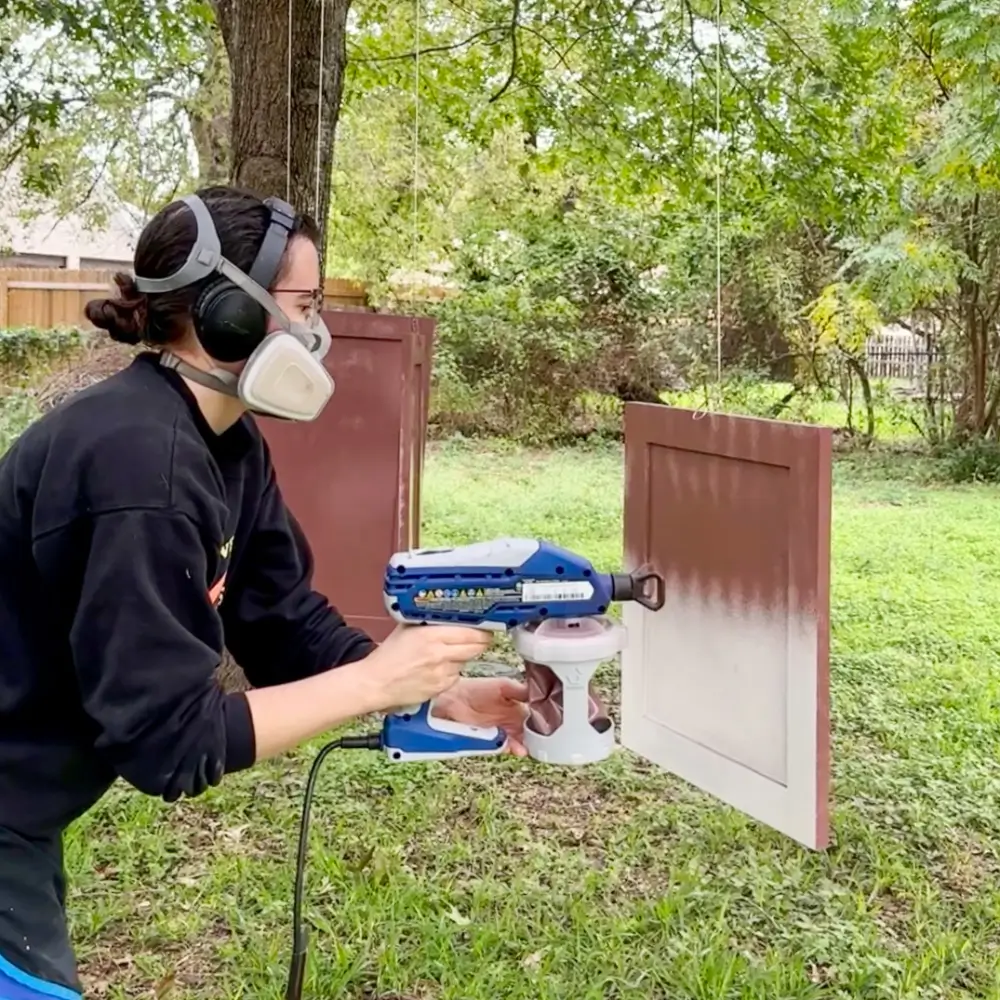Whether you’re painting a door, ceiling, or detailed wainscoting, I’ve got you covered! Here’s a list of all of my favorite painting tools and supplies, including my airless paint sprayers.
This post may include affiliate links, which means I may earn a small commission if you click on the link and/or purchase from that site. I use that money to keep this blog running. You can read my full disclosure policy here.
Paint pail with magnetic brush holder


This paint pail has a large silicone handle that you can easily slide your hand in to grip, or I personally prefer to just hug it to my chest as I work. It’s also the perfect size to fit both a 4-inch roller and a brush at the same time—and my favorite part is the magnet that holds the brush up on the side so that it doesn’t fall in the paint!
You can either clean the pail out after every use or buy plastic liners. I like having the liners because I can switch out the liner and immediately use the pail for a different kind of paint. I also reuse the liners over and over again.
4-inch roller with 3/8-inch nap cover

This is my go-to tool when I’m painting doors, baseboards, and any small or medium flat surface. I use a 3/8″-nap cover even for trim, but if you want an ultra-smooth finish, you can use a foam roller cover instead.
I prefer this kind of 4″ roller that has a rod to hold the cover rather than a wire cage because it’s much easier to clean.
2″ angled trim brush

If you want to save yourself a bunch of painter’s tape and frustration, it’s always a good idea to learn how to cut in. And cutting in is SO much easier when you have a quality brush.
This 2″ angled trim brush is my personal favorite, and the rubberized handle is much comfier than wood when you’re doing a marathon painting session.
9-inch roller and extension rod

Aside from a brush, the 9″ roller is probably the most iconic painting tool. I reach for this whenever I’m painting a large surface area like a wall or ceiling and need to move quickly to keep a wet edge.
I also love this extension rod because it has a rubber bumper on the end, so if you accidentally hit it against a wall as you’re working, it’s less likely to leave a mark.
The Repaint Tray
I recently learned about this product, and it’s a new favorite of mine! It’s a paint tray with a 100% silicone liner and lid. So no more single-use plastic liners AND the paint just peels right off once it’s dry.
It’s a woman-owned small business started by a DIYer and such a genius product. Kudos to her!
Artist detail brushes

I like to use these small artist brushes for getting paint or stain in nooks and crannies, for tiny touchups, and for cutting in with shellac-based or oil-based products that I wouldn’t want to get on my nicer brushes.
It’s always convenient to have a pack of these around just in case.
Floetrol

Floetrol is a paint additive that extends the working time of your paint by helping it dry more slowly. This means that it’s easier to maintain a wet edge and prevent roller marks and brush strokes.
Plus, it adds some self-leveling properties to the paint to provide an extra smooth finish. I always love adding a capful or two of this to my paint, especially with shinier trim paint.
Pre-taped masking film

If you’re ever using an airless paint sprayer or if you just want to be extra cautious about protecting your surroundings as you paint, this is the easiest way to mask things off.
You just unroll the masking film, and the tape is already perfectly attached to the edge for easy application.
Blue and purple tape


Painter’s tape is always good to have on hand, even though I prefer to cut in with a brush rather than tape off my edges. But I do like to use painter’s tape when I mask things off to protect them from overspray when I’m using an airless paint sprayer.
I’ll use blue tape for sealing off masking film, but if I need a crisp line, I think the purple delicate tape actually does a much better job.
Small airless paint sprayer

If you want an airbrushed finish, an airless paint sprayer is for you. The downside of using these sprayers is that they turn the paint into airborne dust particles that get everywhere.
So it’s always very important to mask off everything before spraying, or just opt to use airless paint sprayers outside. This is my preferred sprayer for smaller projects like wainscoting and cabinet doors.
Large airless paint sprayer

If you’re painting a larger surface like an entire ceiling, walls, or siding, I love this large paint sprayer. I originally bought it to paint my 110-year-old cedar siding, and since then it’s come in handy for so many other large painting projects in my home.
Again, be aware that you’ll need to mask off everything before using this sprayer to protect from overspray.
If you want to learn more about how to paint walls, ceilings, and trim, check out my course DIY Renovation for Beginners, where I dedicate an entire module to painting!
